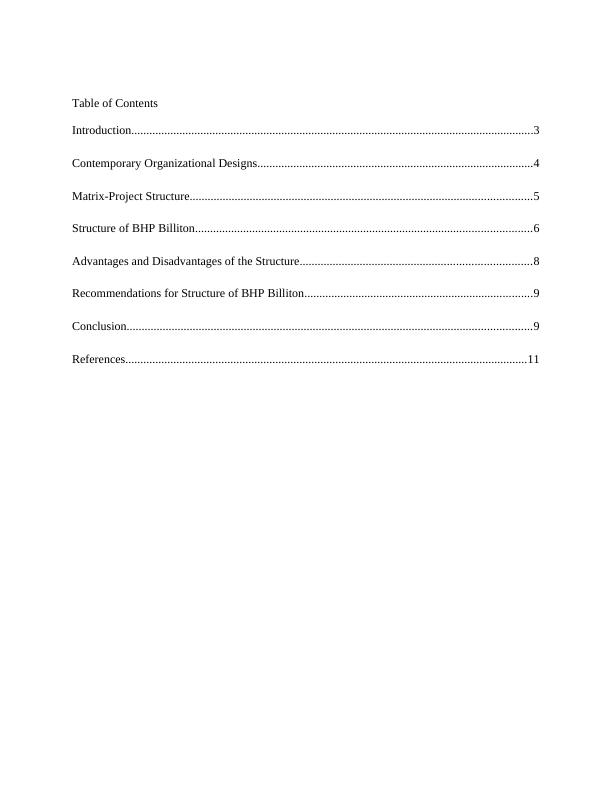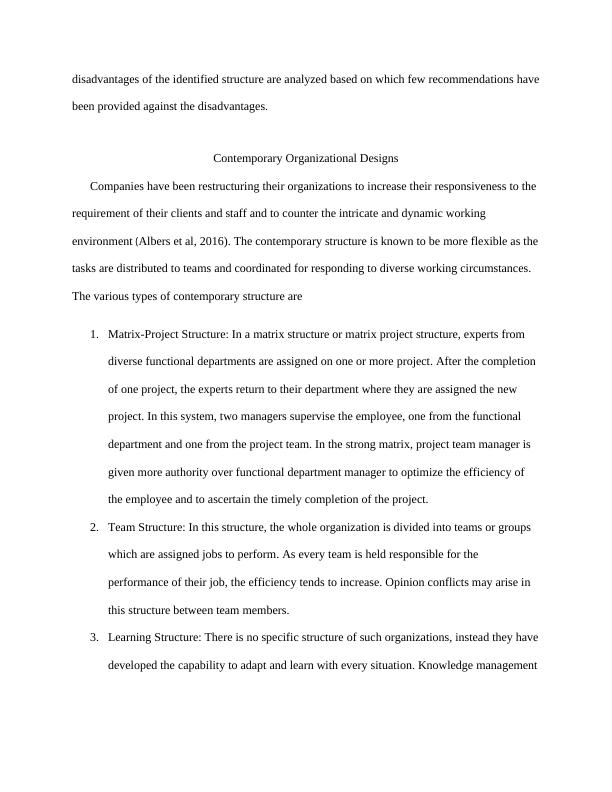Advantages and Disadvantages of Organizational Structure at BHP Billiton
Added on 2023-06-11
12 Pages2607 Words447 Views
Running Head: FUNDAMENTALS OF MANAGEMENT
Advantages and Disadvantages of Organizational Structure at BHP Billiton
Advantages and Disadvantages of Organizational Structure at BHP Billiton

Table of Contents
Introduction......................................................................................................................................3
Contemporary Organizational Designs............................................................................................4
Matrix-Project Structure..................................................................................................................5
Structure of BHP Billiton................................................................................................................6
Advantages and Disadvantages of the Structure.............................................................................8
Recommendations for Structure of BHP Billiton............................................................................9
Conclusion.......................................................................................................................................9
References......................................................................................................................................11
Introduction......................................................................................................................................3
Contemporary Organizational Designs............................................................................................4
Matrix-Project Structure..................................................................................................................5
Structure of BHP Billiton................................................................................................................6
Advantages and Disadvantages of the Structure.............................................................................8
Recommendations for Structure of BHP Billiton............................................................................9
Conclusion.......................................................................................................................................9
References......................................................................................................................................11

Introduction
Structure of an organization is the hierarchy which defines role, function, and reporting
of each personnel. The organizational structure is developed to define the approach through
which the organization operates to accomplish its targets and future growth. Various types of
organizational structures are adopted by different companies which meet their requirement
(Robbins et al, 2003). Few key elements of an organizational structure are centralization or
decentralization, departmentalization, chain of command, work specialization and formalization
etc. Defining a structure has benefits like it establishes a formal line of hierarchy divides the
work into specific teams and eases the coordination between diverse organizational tasks, etc.
Organizational structure has been categorized into the traditional structure and contemporary
structure. In a traditional structure, a line of a hierarchy is designed with the chief executive at
the top who deputies some of his command to immediate senior managers who, in turn, have
numerous managers reporting to them. The chain of command is very simple and the reporting is
very clear but this system lacks flexibility. This system can be adopted if working levels are
certain but in case of an unexpected situation, the reaction time is very slow. The examples of a
traditional system are functional structure, divisional structure, and simple structure. On the
contrary, in the contemporary system, the structure is designed horizontally instead of vertically.
The information is spread out to all parts of the organization and hence the reaction time is
reduced for any change in working level. Though the flexibility is increased in this structure, it
may reduce the efficiency of the organization. It has to be made sure that every employee has the
information they may require for making decisions and it increases the cost of coordination. The
examples of contemporary design are matrix structure, team structure, and learning structure etc.
This report will discuss the organizational structure of BHP Billiton Ltd. Advantages and
Structure of an organization is the hierarchy which defines role, function, and reporting
of each personnel. The organizational structure is developed to define the approach through
which the organization operates to accomplish its targets and future growth. Various types of
organizational structures are adopted by different companies which meet their requirement
(Robbins et al, 2003). Few key elements of an organizational structure are centralization or
decentralization, departmentalization, chain of command, work specialization and formalization
etc. Defining a structure has benefits like it establishes a formal line of hierarchy divides the
work into specific teams and eases the coordination between diverse organizational tasks, etc.
Organizational structure has been categorized into the traditional structure and contemporary
structure. In a traditional structure, a line of a hierarchy is designed with the chief executive at
the top who deputies some of his command to immediate senior managers who, in turn, have
numerous managers reporting to them. The chain of command is very simple and the reporting is
very clear but this system lacks flexibility. This system can be adopted if working levels are
certain but in case of an unexpected situation, the reaction time is very slow. The examples of a
traditional system are functional structure, divisional structure, and simple structure. On the
contrary, in the contemporary system, the structure is designed horizontally instead of vertically.
The information is spread out to all parts of the organization and hence the reaction time is
reduced for any change in working level. Though the flexibility is increased in this structure, it
may reduce the efficiency of the organization. It has to be made sure that every employee has the
information they may require for making decisions and it increases the cost of coordination. The
examples of contemporary design are matrix structure, team structure, and learning structure etc.
This report will discuss the organizational structure of BHP Billiton Ltd. Advantages and

disadvantages of the identified structure are analyzed based on which few recommendations have
been provided against the disadvantages.
Contemporary Organizational Designs
Companies have been restructuring their organizations to increase their responsiveness to the
requirement of their clients and staff and to counter the intricate and dynamic working
environment (Albers et al, 2016). The contemporary structure is known to be more flexible as the
tasks are distributed to teams and coordinated for responding to diverse working circumstances.
The various types of contemporary structure are
1. Matrix-Project Structure: In a matrix structure or matrix project structure, experts from
diverse functional departments are assigned on one or more project. After the completion
of one project, the experts return to their department where they are assigned the new
project. In this system, two managers supervise the employee, one from the functional
department and one from the project team. In the strong matrix, project team manager is
given more authority over functional department manager to optimize the efficiency of
the employee and to ascertain the timely completion of the project.
2. Team Structure: In this structure, the whole organization is divided into teams or groups
which are assigned jobs to perform. As every team is held responsible for the
performance of their job, the efficiency tends to increase. Opinion conflicts may arise in
this structure between team members.
3. Learning Structure: There is no specific structure of such organizations, instead they have
developed the capability to adapt and learn with every situation. Knowledge management
been provided against the disadvantages.
Contemporary Organizational Designs
Companies have been restructuring their organizations to increase their responsiveness to the
requirement of their clients and staff and to counter the intricate and dynamic working
environment (Albers et al, 2016). The contemporary structure is known to be more flexible as the
tasks are distributed to teams and coordinated for responding to diverse working circumstances.
The various types of contemporary structure are
1. Matrix-Project Structure: In a matrix structure or matrix project structure, experts from
diverse functional departments are assigned on one or more project. After the completion
of one project, the experts return to their department where they are assigned the new
project. In this system, two managers supervise the employee, one from the functional
department and one from the project team. In the strong matrix, project team manager is
given more authority over functional department manager to optimize the efficiency of
the employee and to ascertain the timely completion of the project.
2. Team Structure: In this structure, the whole organization is divided into teams or groups
which are assigned jobs to perform. As every team is held responsible for the
performance of their job, the efficiency tends to increase. Opinion conflicts may arise in
this structure between team members.
3. Learning Structure: There is no specific structure of such organizations, instead they have
developed the capability to adapt and learn with every situation. Knowledge management

End of preview
Want to access all the pages? Upload your documents or become a member.
Related Documents
Project Managementlg...
|11
|1641
|357
Managing People in Organisationslg...
|10
|3311
|95
Organisational Behaviourlg...
|8
|287
|131
Introduction to Managementlg...
|9
|2137
|127
Academic Skills for Accountants: Organizational Structures and Market Structurelg...
|14
|3068
|212
Introduction to Managementlg...
|9
|1990
|32
